- Author: Chris M. Webb
There is much community and grower support to stop the Asian Citrus Psyllid (ACP) from becoming established in Ventura County. While it has not yet been identified in our county, it is very close. An ACP was found recently in Van Nuys.
This is an extremely dangerous pest because it can carry the vector for the disease, Huanglongbing (HLB, also known as citrus greening), that destroys citrus trees, orchards and related industries in locations were ACP becomes established.
Invasive pests and disease, such as the ACP/HLB pest-disease complex negatively affect agricultural productivity, public health, natural resource biodiversity and our own backyards.
Thank you all for your support. Please contact our office if you would like hard copy outreach materials for yourself or for groups.
- Author: Chris M. Webb
The Asian Citrus Psyllid (ACP) continues its advance through Southern California. This is an extremely destructive pest. The disease it carries is capable of destroying citrus trees, orchards, and related industries.
An ACP Task Force has been formed in Ventura County. Top priority is to reduce the spread of the psyllid, which in turn will reduce the spread of disease. Your help is needed to stop this pest. You can help in the following ways:
- Do not bring citrus trees, other plants, or fruit into the state from other counties, states, or countries.
- If you have citrus on your property, please check regularly (at least monthly) for signs of infestation. Details on what to look for can be found here.
- Encourage your friends, neighbors and relatives to do the same
- A suspected ACP infestation should be reported immediately to the CDFA hotline at 800.491.1899, or your county agricultural commissioner. The Ventura County Agricultural Commissioner can be reached at 805.933.2926
The Ventura County ACP-HLB task force will be conducting a workshop on February 25, 2010 designed for growers and pest-control advisors. More information about the workshop can be found here.
Our office has outreach materials available to help spread the word. Please contact us if you would like some.
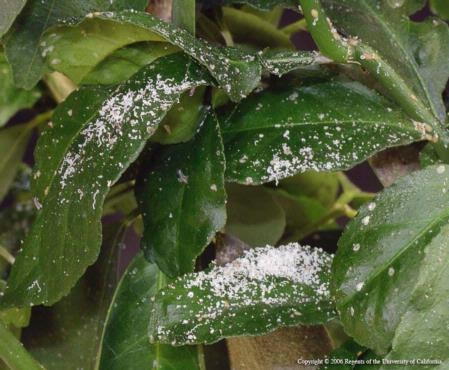
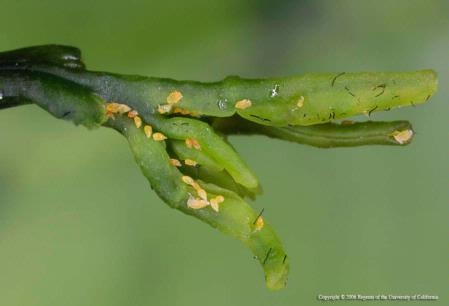
Psyllid eggs and nymphs tucked into crevices and folds.
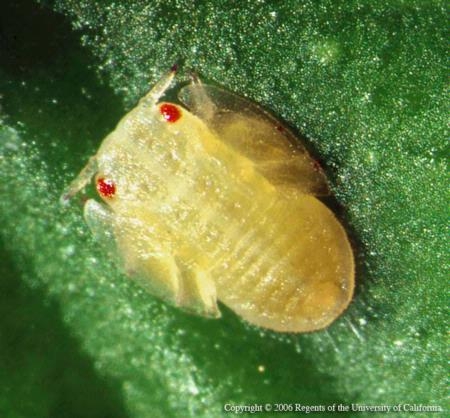
Asian Citrus Psyllid nymph
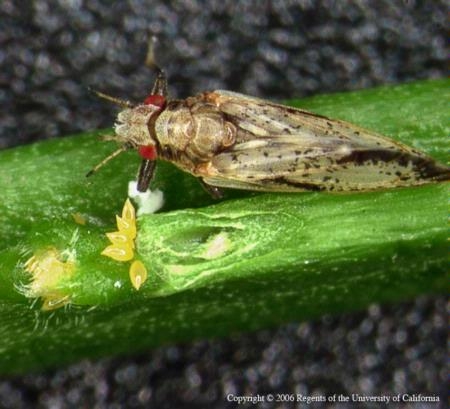
Asian Citrus Psyllid adult
- Author: Chris M. Webb
There have been two earlier posting on this blog about the Asian Citrus Psyllid (ACP)and the potential crippling impact for citrus in California caused by the Huanglongbing vector (aka citrus greening disease) this insect carries. Please read the Introduction to the Asian Citrus Psyllid and Asian Citrus Psyllid: Lessons from Florida for additional information about this pest.
We are entering the time of year in which the ACP becomes most active. Make sure to check your trees regularly for signs of this insect. The Introduction to the Asian Citrus Psyllid post provides detailed photos and descriptions of how to determine if this species is on your trees. If you see this psyllid, call the California Department of Food and Agriculture at 1-800-491-1899 right away.
I recently asked Ventura County UCCE Farm Advisor Ben Faber what I should share about the ACP. He said to remind people how important it is to make sure to declare plant items when crossing the border. It is people who are spreading this around.
Recently UC Agriculture and Natural Resources’ News and Information group released a video demonstrating for the general public how to detect Asian Citrus psyllids on their garden trees. The video is available at:
http://news.ucanr.org/newsstorymain.cfm?story=1233
In addition, our office has a supply of bookmarks that contain photos and instructions for identifying both ACP and trees struck by Huanglongbing. They are available in both English and Spanish. Please contact our office if you would like some.
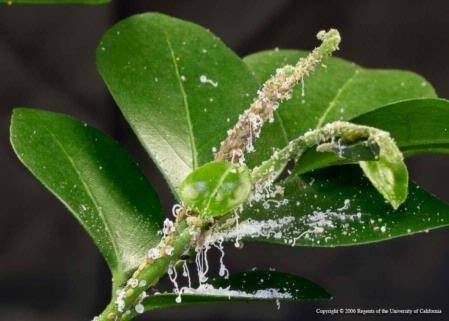
ACP infestation
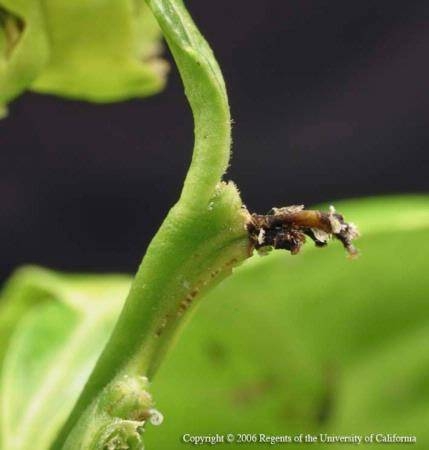
ACP feeding damage
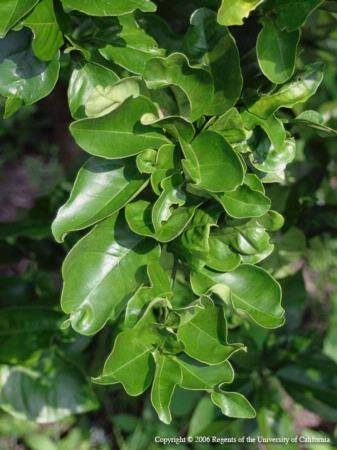
Distorted leaves from ACP
- Author: Chris M. Webb
In 1823, Florida became the first state to plant a commercial citrus grove. The industry and its challenges spread across the southern states of Louisiana, Texas, Arizona and California. Because these areas include many international ports of entry, because of their proximity to international borders and because of their favorable climate, the risk of introduction and establishment of invasive pests and diseases is heightened. In recent years Florida has returned to its status of first in the US: unfortunately Florida has been the first to be hit by many of the potentially disastrous pests facing the citrus industry.
The Asian Citrus Psyllid (ACP), carrier of huanglongbing (HLB) (also known as citrus greening disease), was first discovered in Florida in June of 1998. (See previous blog post “An introduction to the Asian Citrus Psyllid” for details on the insect and disease.)The discovered psyllid tested negative for HLB. At that time the industry in Florida was attempting to eradicate another disease, citrus canker. Some people were unhappy with the aggressive battle against citrus canker, however, and in November 2000, an injunction on inspections and eradication was implemented in Broward County, which may be when and where the Florida HLB epidemic began.
In October 2005, HLB was known to exist in two counties. By the time it was discovered, however, the problem was well established. By August 2008, 32 counties were infected.
In late 2005 and early 2006 key citrus stakeholders formed the Citrus Health Response Program (CHRP). This organization’s focus is a holistic approach to protecting the industry: developing and implementing minimum standards for inspection, regulatory oversight, disease management, and education and training. The goals are developed by five sub-working groups:
- Nursery and Budwood Working Group
- Production Practices Working Group
- Packing Working Group
- Processing Working Group
- Harvesting Working Group
- Residential Citrus Working Group
Common themes within CHRP are:
- The need for education and training, research, and a balance of regulatory oversight with industry due diligence
- Flexibility in adjusting to new information
- Requirements that are based on sound science and the principles of plant quarantine
It is important that we in California and other citrus-producing states learn from the hard lessons Florida is experiencing. The ACP has already been found in our state. Although HLB has not yet been detected, our response must also be organized, science-based, and flexible to sustain an important California industry.
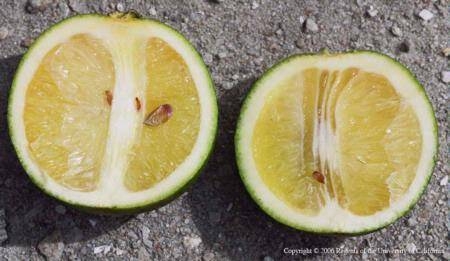
- Author: Chris M. Webb
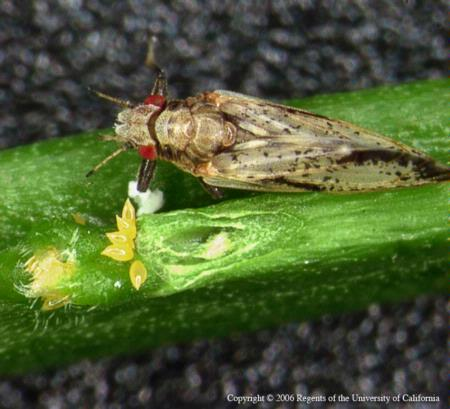
The tiny Asian citrus psyllid (ACP) has the potential to wipe out the California citrus industry. It is a carrier of the deadly bacterial plant disease, Huanglongbing (HLB), which is also known as citrus greening disease. This disease is fatal to citrus trees.
The insect feeds on citrus leaves and stems. Unfortunately, ACP has already been found at several sites in California. It threatens not only the commercial citrus industry, but also the ability of California residents to grow citrus at their homes.
It can take years for the symptoms of HLB to appear. Inspection and elimination of ACP is our first line of defense. Signs of disease include: asymmetrical yellowing and splotching of leaves; new growth is misshapen and twisted; produces bitter, inedible, misshapen fruit.
To help stop the spread of this insect and disease: inspect trees monthly and whenever watering, spraying, pruning or tending to trees; plant only certified disease-free citrus trees from a reputable nursery; do not bring any plant material into California from other states or countries.
At the end of this post you will find a presentation from the Citrus Research Board, provides additional information and photos. Topics covered include: other plants that can be attacked by the psyllid; maps showing locations of pest and disease; ways that the pest moves around; what happens when ACP is detected; how an infestation affects commercial citrus orchards.
If you find the Asian citrus psyliid, call the CDFA hotline at 800.491.1899 right away.
To learn more about the Asian citrus psyllid and HLB disease, or to download printed materials in English, Spanish and Chinese, please visit www.californiacitrusthreat.com.



